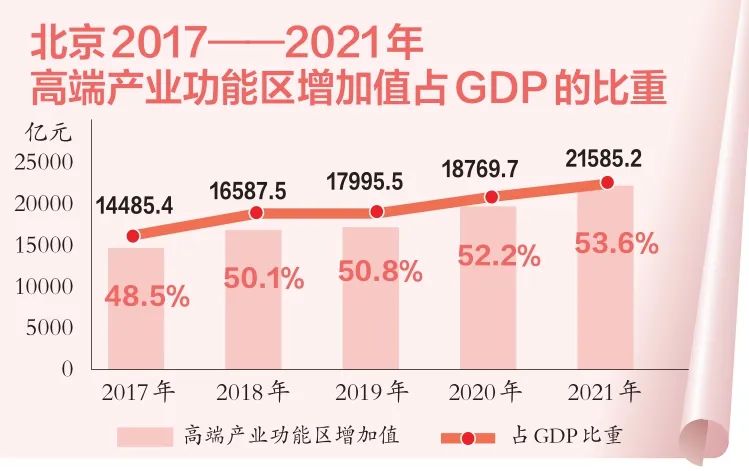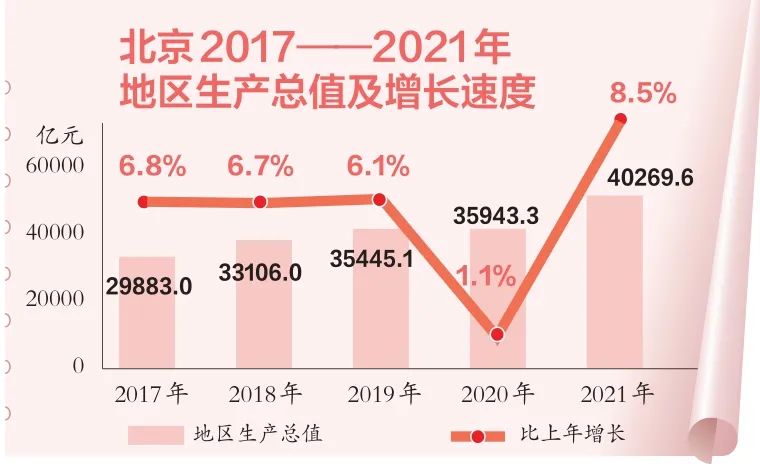Beijing per capita GDP has risen by 40 % in five years, and continues to lead the country. The high -end industrial functional zone supports the capital economy halfway.
Author:Beijing released Time:2022.06.19

In the past five years, Beijing's economic and social development has continuously achieved new achievements. Recently, the Municipal Bureau of Statistics issued the "Fen Duke's Development Development to the Future -A Review of Beijing Economic and Social Development from 2017-2021". Data show that the city ’s gross product has exceeded 3 trillion yuan in 2018 and exceeded 4 trillion yuan in 2021. It only took 3 years to jump from 3 trillion" steps "from 3 trillion. Beijing per capita GDP exceeded US $ 20,000 in 2017 and exceeded $ 28,000 in 2021. In a few years, it increased by 40%, and continued to rank first in provincial -level regions in the country.


(Drawing/Hao Wenhua)
The proportion of digital economy increases by 4.1 percentage points
In the past five years, under the test of complex and changeable external environment and new crown pneumonia, Beijing has successfully completed the 70th anniversary of the founding of the People's Republic of China and the 100th anniversary of the founding of the Communist Party of China, the “Belt and Road” International Cooperation Summit Forum, China -Africa Cooperation Forum Beijing Summit, World Horticultural Expo and other major event service guarantee tasks, carefully organize and organize the Winter Olympic and Winter Paralympic Games to promote the development of the capital.
Under the general tone of "steady progress", Beijing has continuously cultivated the new momentum of economic development, the economic strength continues to improve, and the high -quality development has taken a solid step.
From the perspective of economic structure, the value -added of the service industry accounts for more than 80%of GDP; the high -end characteristics of the industry are more obvious. The proportion of industries is around 1/4 (the two have cross), and the cultural industry has grown and grew, and the value -added accounted for more than 10%of GDP, ranking first in the country.
The leading role of the capital innovation is more prominent. Data show that the total proportion of GDP expenditures for the development and test development (RD) of the whole society in 2020 was 6.44%, an increase of 0.95 percentage points from 2016; of which basic research funds accounted for 16%of RD funds, an increase of 1.8 percentage points, accounting for the whole country 25.4%of basic research funds have become the core force of the original innovation of the country.
The city's economic development efficiency has improved significantly, and the level of energy efficiency has stabilized at the forefront of provincial -level regions in the country. In 2020, the total energy consumption was 67.621 million tons of standard coal, which was a standard coal of 1.5.46 million tons from 2016. Based on comparable prices, the energy consumption of 0.21 tons of 10.21 tons of GDP was less than half of the national average.
The city's permanent population decreased by 68,000
Guided by regional function positioning, Beijing actively promotes the optimization and adjustment of urban space layout, focuses on key demonstration parks and advantageous industries, strengthens high -end functional agglomeration, and accelerates the construction of a new space pattern.
The core area strengthened government affairs and cultural functions. At the end of 2021, the permanent population accounted for 9.7%to 8.3%of the city, and the average number of employees of legal person units decreased by 10.9%compared with the high point in 2018. The proportion of resident population in the central urban area decreased by 7.5 percentage points. The region concentrated 90 % of the city's high -tech service and cultural industries, and GDP accounted for over 70 % of the city's proportion. The "multi -point" regional manufacturing chain is relatively complete. Among the total industrial output value above designated size, over 40 % of the output value of over 40 % of the high -tech manufacturing industry and over 50 % of the strategic emerging industries are produced here. The Tongzhou District where the sub -center is gradually improving the comprehensive urban function. The regional GDP accounts for increased from 2.8%in 2016 to 3%, and the permanent population accounts for 6.6%to 8.4%. The green development of ecological conservation areas has achieved remarkable results. The forest coverage rates in each district are above 48%, and the total rural tourism revenue remains above 1 billion yuan.
The key functional area presents the agglomeration effect. The high -end industrial functional areas such as Zhongguancun National Independent Innovation Demonstration Zone accounted for half of the city's economic aggregate. In 2021, the added value was 2.2 trillion yuan, accounting for 53.6%of the city's GDP, an increase of 5.3 percentage points from 2016.
As the first city in the country to propose reduction and development, Beijing has implemented a special actions to promote relief and rectification. Since 2017, a total of 1,871 general manufacturing enterprises have been withdrawn, 644 of the regional wholesale markets and logistics centers, and the centralized relief tasks are basically basic. Finish. The permanent population has decreased year by year since 2017. At the end of 2021, it was 21.886 million, a decrease of 68,000 from the end of 2016.
The average annual growth rate of per capita disposable income is 5.4%
In the past five years, the city has continuously improved the public service system, and the city has become more harmonious and livable.
Data show that in 2021, the average concentration values of the annual concentration of the main pollutants, sulfur dioxide, nitric dioxide, fine particles (PM2.5), and inhaled particulate matter (PM10) decreased by 70%, 45.8%, 54.8%, and 40.2%compared with 2016, respectively. The experience of air pollution control was included in the "practical case" of the UN Environment Agency. The city's forest coverage rate increased from 42.3%in 2016 to 44.6%in 2021, and the 500 -meter service radius coverage rate of 500 meters of green space in the construction district reached 86.8%.
Traffic travel is more convenient. In 2021, the total mileage of rail transit operations is 783 kilometers, and the suburban railway runs nearly 400 kilometers, an increase of 36.4%and 3 times compared with 2016; the green travel ratio of the central urban area has increased from 71%in 2016 to 74 in 2021 in 2021 %.
Beijing education, medical care, pension, sports and other public services are the leading in the country.In 2021, education expenditures accounted for 15.9%in general public budget expenditures, an increase of 2.1 percentage points from 2016.The city is the first to build a social security system that is unified and covered by the whole people. At the end of 2021, the number of people participating in the basic care of employees, basic medical care, unemployment, work injury and maternity insurance in the enterprise employee increased double -digit growth compared with the end of 2016.Residents' living standards have been in a new level.Data show that the per capita disposable income of residents in the city exceeded 60,000 yuan in 2018, reaching 75002 yuan in 2021, and an average annual growth rate of 5.4%from 2017 to 2021. Among them, the average annual income of rural residents increased by 6.3%, which was faster than urban residents.1 percentage point.The consumption structure of residents continued to upgrade, and per capita consumption expenditure increased from 35,416 yuan in 2016 to 43,630 yuan in 2021. Among them, the proportion of service consumption has more than half since 2016, and 57.1%in 2021.
Source: Beijing Daily Reporter: Chen Xuemian
- END -
11 prefabricated vegetable industrial parks in Guangdong will build Jingdong Network Marketing Platform

Seize the new opportunities for the construction of a unified market in the countr...
Closer shops, punishment, and complaints constantly "dismiss" young people

China Commercial Daily (Tang Yan reporter Ma Wenbo Wen/Picture) Recently, a report...